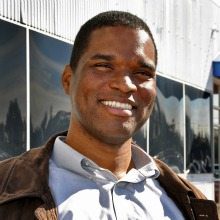
Three engineers from the Space and Naval Warfare Systems Center Pacific (SPAWAR/SSC Pacific) were awarded with Black Engineer of the Year Awards (BEYA) by the Career Communications Group (CCG), Inc. during the 27th annual BEYA Science, Technology, Engineering, and Math (STEM) Conference, held Feb. 7-9 in Washington, D.C. Ayodeji Coker, Lilton Hunt and Dwayne Lloyd were all recognized for their exemplary achievements as part of the Navy’s critical STEM workforce preparing Navy warfighters for the new age of information warfare.
“I’m proud to have three of SSC Pacific’s engineers selected to receive Black Engineer of the Year awards,” said Capt. Joe Beel, SSC Pacific’s commanding officer. “Their individual contributions to enabling information dominance for our warfighters has been superb, and this recognition is well deserved.”
Coker, a computer engineer at SSC Pacific for three years, received the BEYA Most Promising Scientist Award for his past accomplishments and future potential. Bryan Scurry, command and control department head at SSC Pacific, considers him to be a “young, energetic and a visionary leader within our research core of engineers and scientists.”
Coker is currently working on the Adaptive Intermittent Communications Capability for Enhanced Autonomy in Unmanned Surface Vehicles project, part of the Naval Innovative Science and Engineering Program. He is developing a methodology and tool for predicting the probability of achieving communication between heterogeneous teams of unmanned vehicles operating in maritime and joint military environments.
“This new capability is a key enabler to the future warfighting capability of the Navy and military,” said Scurry. “Dr. Coker’s leadership and teambuilding skills are unique in that he has tailored his project team to include engineering and scientific expertise from recent college graduate interns to seasoned subject matter military experts.”
Lloyd, a project manager and integrated project team lead, was the 2012 BEYA Modern Day Technology Leader Award recipient. Since retiring from the Navy with 26 years of active-duty service, he has spent the last seven years managing all U.S. Pacific Fleet installation and modernization efforts as part of a larger goal of using research, development, delivery and support of integrated capabilities to enable warfighter information dominance.
“I love being so close to the fleet, visiting the ships and seeing the direct impact we provide through networks, radio frequency systems and other means, said Lloyd. “It’s a great feeling to know that I’m directly supporting the defense of our nation and helping to make our Navy the strongest, most capability fighting force in the world.”
Hunt was presented with the BEYA Special Recognition Award for his support of the warfighter, including supporting the advanced electromagnetics technology branch, where he was selected by the Navy’s Communications and Global Positioning System Navigation Program Office (PMW/A-170) to serve as assistant program manager for science and technology. The program office asked him to take the lead role for integrating communications systems on unmanned aerial vehicle platforms.
“I met with an SSC Pacific recruiter during graduate school at Michigan State University,” said Hunt. “She painted a picture of a Department of Defense research organization that encouraged research and offered a fair amount of independence in determining what one would work on to contribute to the warfighter.”
Hunt is a 10 year veteran of SSC Pacific, after starting out in the New Professional group.
“I enjoy working on cutting-edge technologies, improving existing capabilities, and finding new ways to keep old technologies useful,” Hunt said. “I enjoy the broadness of the experience I have had at the Center: being able to contribute to pure research efforts, engineering and design of systems now deployed, and solving shipboard technical problems while at sea on deployed vessels.”
Beel acknowledge the value of diversity within his department. “The sharing of ideas and experiences by personnel of various backgrounds ensures a richness to the collaboration and communication across our workforce, inherently bringing out new and innovative ideas, which are vitally important to our work.”


